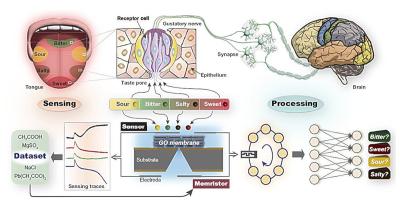Researchers at the Chinese Academy of Sciences (CAS) and Shandong University of Technology have developed a new graphene oxide-based sensor design that, through machine learning, was able to develop a near-human sense of taste. This device is uniquely able to operate in a moist environment, better approximating the conditions inside the human mouth.
Image from: PNAS
The sensor was made of multiple layers of graphene oxide enclosed in a nanofluidic device. Graphene oxide is known to change its electrical conductivity when exposed to different chemicals. The researchers used this property to measure electrical variations in the sensor when it was exposed to a sampling of 160 chemicals, each associated with a unique flavor profile. Using these data, a machine-learning algorithm was able to create a ‘memory’ of flavors.
This learning process is analogous to the way the human brain interprets signals from our taste buds when they react to chemicals in our foods. It was long held that humans could detect five distinct tastes: sweet, salty, bitter, sour, and umami. In 2023, researchers isolated a sixth flavor, ammonia chloride.
During testing, the new artificial tasting system’s algorithm, which was trained to classify four basic tastes (sweet, salty, bitter, sour), could readily identify tastes it had already experienced with an accuracy of around 98.5%.
It was also able to categorize flavors of 40 samples it hadn’t previously encountered, with an accuracy ranging from 75% to 90%. The researchers also trained the algorithm to identify the more complex tastes of coffee and cola.
Addressing one of the limitations of previous artificial gustatory systems, the new design integrated the sensing and computing functions of taste perception into a single nanofluidic device.
According to the authors, this system has the potential to one day restore taste perception to people who have lost that ability due to stroke, viral infection, or a range of neurodegenerative conditions.
There are a number of technical hurdles to overcome before that time, however. The complete system, which was designed as a proof-of-concept experiment, is relatively bulky with concurrently large energy demands. The researchers note that further miniaturization and integration are needed for practical applications.
